44 Brunswick Place
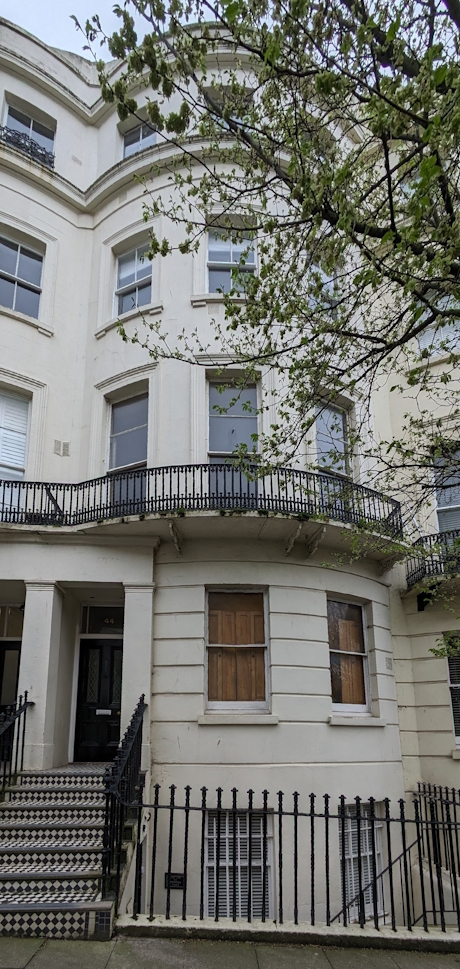
44 Brunswick Place in 2024
In its early days this street was, as it is now, known as Brunswick Place. However, as the street continued to be developed in the 1850s, it began to be distinguished as Upper and Lower Brunswick Place with Lower Brunswick Place leading immediately onto Western Rd from Brunswick Square. Upper Brunswick Place, which was to the north, led into Lansdowne Rd. Prior to 1878 when houses in Brunswick Place were renumbered, our house was for some of the time 45 Brunswick Place or 45 Upper Brunswick Place.
The Freehold of our property, (then 45 Brunswick Place), was first held by William Hedges Esquire of Streatham Hill with a Deed drawn up between him and the landowner Sir Isaac Lyon Goldsmid on 31 July 1854.
Shortly before William Hedges entered into the Freehold, his son and heir William Killingworth Hedges had died. His Last Will &Testament sets out the family circumstances and their connections to Brighton.
The Hedges family had moved within a couple of generations from being general provisions traders to become one of the most established and reputable wine merchants across the British Empire and were, in today’s value, multi-millionaires.
William Hedges was born on 4 Mar 1787 at St Martin in the Fields and baptised there on 1 Apr 1787. William and Mary followed his family into a chandler’s business in Hungerford Street near the Strand which traced its origins back to 1667 in the reign of King Charles II. The longevity of their business achievements was proudly displayed on all their advertisements. In 1733 the business had been taken over by an earlier William Hedges who is described as a wax and tallow chandler. Receipts show Killingworth & Hedges, Tallow chandlers as suppliers to George, 3rd Earl Egremont for work on Egremont House, Piccadilly, in 1782 and we can assume this is the same family.
By 1819 our William Hedges had moved their thriving business to 153-155 Regent Street, London, where it traded as Hedges &Butler. His son, William Killingworth Hedges, had married Harriet Butler and her brother James Butler appears to have been in business partnership with both William Hedges equally. By 1830 the business was granted a Royal Warrant by King William IV and became a supplier of fine wines to successive British and European monarchs. As well as trading in Regent Street, Hedges & Butler had further outlets in Brighton and Bognor. Adverts of the period show 30 Kings Rd Brighton as part of their business. (They also seem to have owned 29 Kings Rd Brighton.)
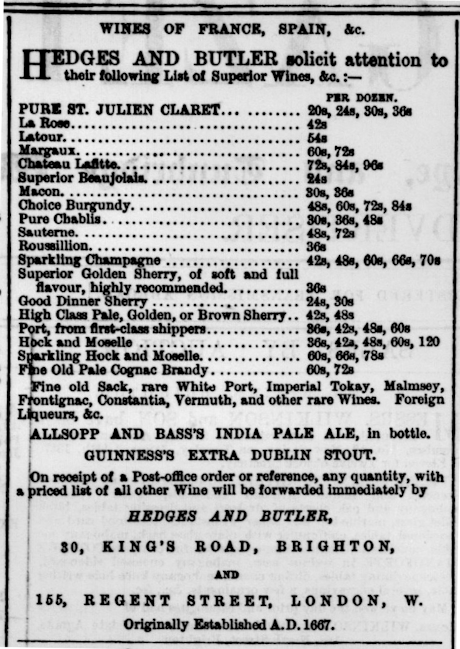
Advert from the Brighton Gazette 1867
Such were the family connections that William Killingworth Hedges made specific bequests in his Will relating to Brighton. Firstly the ‘Hedges and Butler Bequest under the control of the Old Church Brighton to divide half investments from his Brighton business as money, clothing or fuel, to be given out on the 23rd of May (the anniversary of the opening of their business) between two poor male inhabitants of the parish over the age of 60 who have never received parochial relief.’ The bequest was to be commemorated on a brass plate in the Parish church. The second bequest was for his remaining investment to be divided ‘between each Clerk or Assistant and Porter, Cellarman or Carman that have lived at least seven years in our service at Brighton, the Clerk or Assistant to take double the share of the Porter, Cellarman or Carman, but if it happens that no-one is entitled to this bequest then this second part is to be re-invested and added to the former one left to the two parishioners’.
William Hedges clearly maintained his business and private connection to Brighton, with society announcements in the Brighton Gazette of Thursday 19 February 1863 reporting, ‘Mr. Hedges has arrived at 45 Brunswick Place’. It would appear he was both Freeholder and part-time occupant of our property in its early years. William Hedges died on 9 September 1872 and left probate of £250,000 (equivalent today to approx. £23,400,000). The Freehold of Brunswick Place was clearly retained by the Hedges family for some time, so that in 1904, when it had been re-numbered from 45 to 44, the sale of 44 Brunswick Place is described as in the Freehold of the late Mr. Hedges.
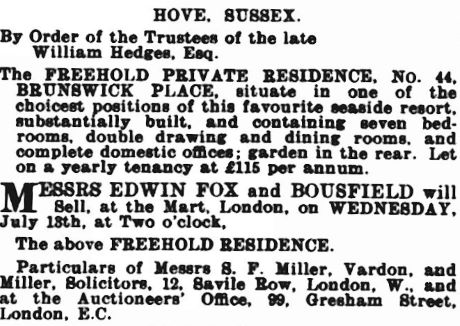
Brighton Gazette 16 June 1904
Curiosities about our Freeholder: 153-155 Regent Street London is now known as Hedges House. The site was rebuilt for Hedges & Butler with a new wine merchant shop in 1922 and a time capsule placed in the foundation with instructions for it not to be opened for 100 years, the time capsule has not been located.
Aside from William Hedges there were a number of short-term residents at Brunswick Place from 1860 to 1880.
In 1861 Lady Elizabeth Prendergast, the widow of General Sir Jeoffrey Prendergast, lived at our property along with her adult children Dorothea and Thomas. Theirs was perhaps a typical story of Empire with Dorothea and Thomas having been born in Madras, a reflection of the military postings of their father, who had risen through the ranks in the employ of the East India Company. General Sir Jeffrey Prendergast had died in 1856 and his widow may have taken the lease of 44 Brunswick Place for health as well as society reasons as the family appear to have maintained a London address at the same time. Lady Prendergast died in 1863 aged 83 and family connections to Brunswick Place closed thereafter. (This may be why Mr Hedges is announced as returning to Brunswick Place in February 1863.)
Staying with our property in 1871 it is still given as 45 Upper Brunswick Place and will not alter its number or street name for a few years yet!
The 1871 Census shows the premises were now a school run by a Miss Henrietta C Scott, born 1831 in Brighton. Henrietta Scott and her sister Mary E F Scott appear in the 1851 census as resident with their aunt, another Mary Scott, who is a schoolmistress at 41 Brunswick Square, a private girls’ school. It seems likely therefore that Henrietta was a teacher there before moving premises just round the corner to Brunswick Place. By the 1850s onwards the newspapers are full of classified advertisements for the daughters of gentlemen to receive an education suited to their social standing. These adverts from the Brighton Gazette in 1855 are typical of the period.
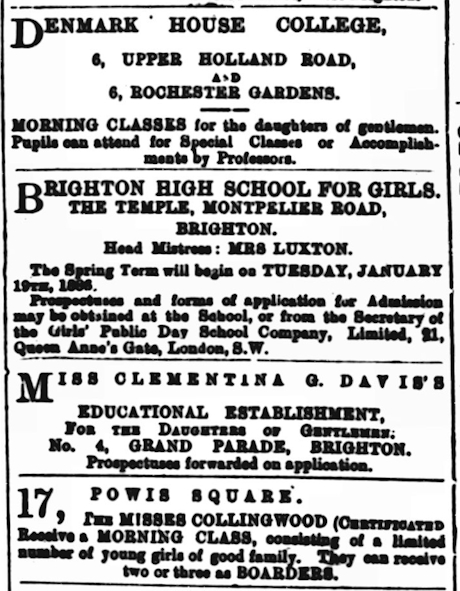
Brighton Gazette 25 December 1885
In the 1871 Census, Henrietta describes herself as Headmistress at 45 Brunswick Place. Under her headship were an English Governess, a Foreign Governess and a Governess Pupil. Interestingly the ‘Governess Pupil’ was a 15-year-old and the same age as the oldest pupils. It was not uncommon for a more capable student to act as a mentor to other pupils. We do not know if her role reduced her fees or provided some income, but it would seem likely. Eight girls between the ages of 10 to 15 are listed as scholars and a further three young women all from Sussex are in service as housemaids and as charwoman. Henrietta Charlotte Scott appears to have run her ‘ladies’ school’ at 45 Brunswick Place until at least 1873 but by the 1881 census she has moved location to 4 Third Avenue Hove where she is headmistress of another private school employing all female staff in English, German and French. Her intake of pupils has almost doubled but they are at an older range mainly 14 to 16 years and from across the UK with one or two girls born in what would have been British Empire countries. The private education of middle-class girls had become increasingly fashionable and from the mid-1800s was considered a means of giving them some sophistication in the arts and languages prior to securing a good marriage. In some instances, but with rarity, this also allowed for matriculation and entry to university.
Returning to our house, it is now 1881 and the address has at last settled on its number and street name to become 44 Brunswick Place, as it is known today. The 1881 census shows that for the first time a family are residing there. They are Joseph Salomon born Marylebone in 1838 who gives his occupation as Captain 2 Tower Hamlets Engineer Volunteers living with his wife Lisette and their three daughters Alice 17, Nellie 13 and Bertha 9 years old all described as scholars and son Philip 4 years. The household has four servants comprising a private governess, Mary Ann Russell b Clerkenwell 1849, a butler, Jonah Bates b Bucks 1808, a cook, Eliza Adams b Blockley Worcs b 1831 and a housemaid, Sophia Willcess b City of London 1860.
The 2 Tower Hamlets Engineer Volunteers were formed in 1868 replacing the 1st Tower Hamlets Engineer Volunteers and were based at Gretton Place, Bethnal Green. As their title suggests they were a volunteer unit of what was to become the British Royal Engineers and took their title, not from the modern borough of Tower Hamlets but from the historic Tower division or Tower Hamlet. Their motto ‘Peritia Potius Quam’ means Skill rather than force.
We do not know if this role provided an income or what it demanded of our Captain Salomon. As we have seen from the earlier description of the sale of the house it was a substantial property, but the household described in the 1881 census seems at odds with this fashionable address. What was the income that supported a family and their servants at this address and why were they employing amongst others a 73-year-old butler?
Joseph Philip Salomons was the son of Cecilia Salomons (Samuels) and her first husband Philip Joseph Salomons. The 1861 census shows all of them at 18 Upper Wimpole Street along with Joseph’s sisters Amelia and Henrietta. Joseph is 23-years-old and described as a Captain 3rd City London Volunteers, which may have been a forerunner to his later engineering interests. His father, Philip Joseph born 1797, is described as a Fundholder. Amongst the household’s eight servants is the familiar name of John (Jonah) Bates b Aylesbury Bucks 1809, then described as a widower and butler.
Amazingly the 1841 census which gives 3 -year-old Joseph, his sisters Anna and Bertha and their parents Cecilia and Philip Salomons at Upper Wimpole Street, also shows amongst their six servants a male servant, John Bates then age 30 years. It would seem therefore that our 73-year-old butler at Brunswick Place had been in the employment of the Salomons family across the generations and for many years. We don’t know if Jonah Bates was retained by Joseph Salomons at Brunswick Place to provide some security in later age or whether he took on his butling duties in full.
Joseph seems to be very well connected to Brighton. He appears twice on 1851 census entries both at his family home in London and as a 13-year-old scholar at 214 Buckingham Place Brighton under the headmastership of Louis Lorine.
Joseph Philip Salomons came from a very prestigious background and was a cousin to the Salomon family who resided at 26 Brunswick Square and later at Brunswick Terrace. His father Philip Joseph Salomons was described as an ‘eminent amateur musician’ whom Rossini had composed for but was also part of the Salomons banking family and of considerable means. A first cousin to Philip and David Salomons, Philip Joseph Salomons supported the arts and was frequently reported as a fundraiser at Convent Garden. Joseph’s mother Cecilia on being widowed remarried to Sir David Salomons and thus Joseph was doubly connected into this family whose intermarriages with the Goldsmids and Montefiores further connected him to Brighton. Despite these connections, Joseph did not remain at Brunswick Place beyond 1889 and his family seem to have moved to Scotland whilst retaining their London links.
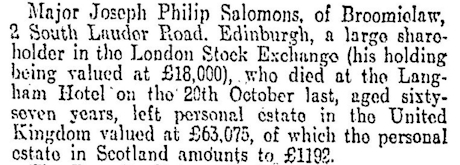
The Scotsman 28 December 1905
Two more families will live at the property in its full capacity before it becomes a house of multiple flats and occupation.
By 1889 Charles Pratt Barlow is recorded on the electoral roll at 44 Brunswick Place. The 1891 census shows they are a second family with four servants, (almost as grand as the Salomons), at the address. The head of household Charles James Pratt is described as ‘own means’ although an earlier census leaves us in no doubt stating ‘stocks, shares, Freehold and Leasehold Property'. His wife Rosa Caroline, nee Gladstone, is a cousin to William Ewart Gladstone, Prime Minister at the time this family were in residence at Brunswick Place. Their servants are all female and include a cook and a nurse. The nurse is possibly employed for the care of their youngest son Reginald aged four years.
Their eldest son Bernhard has taken an apprenticeship in 1889 at 14 years of age.
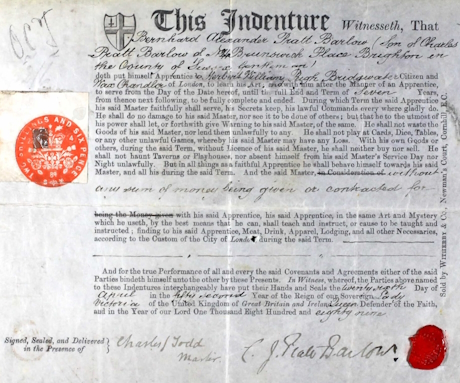
Apprenticeship indenture
However, two years later he has enlisted as a Royal Naval cadet. By 1897 the Barlow family have moved to Plymouth, and this is possibly to remain in touch with Bernhard. This is an age group that will see action in World War I and Bernhard is no exception.

Hampshire Telegraph and Post 06 November 1914
Brunswick Place is changing in the late Victorian period and has seen the last of its full family and servant groups. By 1897 Pikes Directory shows Mrs Lever as resident at No 44.
Sarah Maria Lever nee Rodgers was born in Yorkshire in 1846. She married Charles Baldwin Lever on 1 December 1869, in Scarborough Yorkshire. Charles was a London solicitor and son of a solicitor. The family lived in Hyde Park, however in December 1874 less than five years after marriage and with two young children, Sarah was widowed. From at least 1881 Sarah Lever lived with her sons, Charles Reginald Lowthorpe Lever and Albert Stuart Lever at 101 Lansdowne Place, Hove. Her eldest son, Charles became an engineer. Her younger son Albert Stuart Lever had been ordained at Chichester and in December 1896 the Bognor Regis Observer reports the diocese he will serve.

Bognor Regis Observer 23 December 1896
It may be that Albert’s ordination precipitated their move to Brunswick Place within the next year. The family remained at 44 Brunswick Place for a good length of time with Sarah and her youngest son Rev. Lever shown on both the 1891 census along with three servants and the 1901 census with two servants. We don’t know if they stayed beyond 1901 but the sale of the property in 1904 suggests that not only were they the family who remained for the longest duration but that they were also the last to reside in the entirety of the house.
The 1911 census shows two servants at the address, a housemaid, Agnes Sheppard from Petworth 29 years of age and a cook, Bertha Horther 42 years of age from Switzerland. This suggests that there was no one family fully resident at 44 Brunswick Place and that it may have been used on short term lease or have only been used seasonally. The 1921 census confirms for us that the days of this being used as a fashionable address by one family are in decline as the property is now divided into 44 and 44a each with a family group and each with two servants. Within the next few years 44 Brunswick Place will be converted further into multiple occupancy flats yet still retain its fashionable position as a gateway into Brunswick Square and views of the sea.
Research by Rachel Pope (May 2024)
Return to Brunswick Town page


